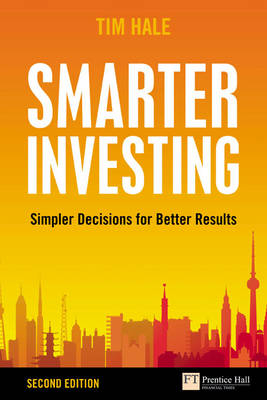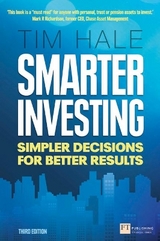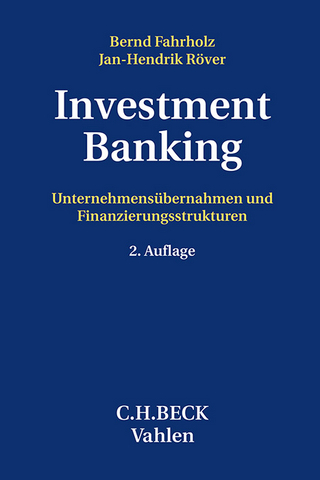
Smarter Investing
FT Press (Verlag)
978-0-273-72207-6 (ISBN)
- Titel erscheint in neuer Auflage
- Artikel merken
'A book of investment wisdom'John C Bogle, Founder, Vanguard
'Delightfully clear thinking', Charles D Ellis, Founder of Greenwich Associates
'This book is a 'must read' for anyone with personal, trust or pension assets to invest', Mark R Richardson, former CEO Chase Asset Management
Simple and effective advice for anyone who wants their money to work harder than they do.
Most investment books offer a bewildering array of complex strategies for how best to invest your money. But often the chances of success are remote and the rules are impossible to follow in practice.
Smarter Investing introduces you to a simple and powerful set of rules for successful investing, helping you to build an investment portfolio that suits your needs, stays the course when markets get rough and quietly gets on with the job of generating better results.
In this updated and revised edition, Tim Hale gives you all the advice you'll need and demonstrates that the key to successful investing is to do a few straightforward things exceptionally well. Smarter Investing will help you:
Establish what you want your money to do for you
Work out how much money you need to achieve your goals
Avoid the mistakes that generations of investors have made
Build a balanced portfolio that's right for you, using a simple set of understandable and accessible building blocks
Select robust and transparent investment products easily and effectively
Tim Halespent over 15 years in the active investment management world, working in London, New York, Hong Kong and Tokyo. Today he provides consulting and training to the investment and wealth management industry through his firm, Albion Strategic Consulting.
Tim Hale has spent over 15 years in the active investment management world, working in London, New York, Hong Kong and Tokyo. Currently he leads his firm Albion Strategic Consulting, in providing consulting and investment training to the investment and wealth management industry, which he set up in 2001 after working at Chase Asset Management (now part of JP Morgan), in both sales and strategy roles. This experience has provided a unique insight into the struggles that most investors face, an inside view of good and bad practices of the industry and a determination to share this knowledge through his consulting and training business, and this book. Tim holds an MBA from Cranfield School of Management and an Honours degree from Oxford University. He lives in Devon with his wife and two young daughters, writes articles on investing for fun and disappears regularly to work with his clients in the US and the UK.
Preface
Publisher's acknowledgements
Author's acknowledgements
Foreword
Introduction
I.1 What should I do with my money?
I.2 Some eye-openers to get you thinking.
I.3 How this book will help you
I.4 How this book works
I.5 A few points to note
Part 1: Smarter investing basics
Chapter 1: Simplifying the confusion
1.1 Choices, choices, choices
1.2 How did we get here?
1.3 Battling for investors' money
1.4 Reducing confusion and complexity
Chapter 2: Covering the basics
2.1 What is smarter investing?
2.2 Ten points of focus for smarter investors
2.3 The two distinct phases of investing
2.4 There are no perfect answers
2.5 Summary: smarter investing basics
Chapter 3: It only takes a minute
3.1 Twenty tips for smarter investing
Part 2: Smarter thinking
Chapter 4: Get smart - find your philosophy
4.1 Don't be a loser
4.2 The foundations of your philosophy
4.3 The path to establishing your philosophy
4.4 Can active managers win?
4.5 Do a few managers outperform over time?
4.6 Can you identify them in advance?
4.7 Don't just take my word for it
4.8 Summarising what you now know
4.9 A personal philosophy
4.10 Your investment philosophy rules
Chapter 5: Get smart manage your emotions
5.1 You are your own worst enemy
5.2 Challenges to decision-making
5.3 Thirteen questions for you to answer
5.4 Ms. Rational versus Mr. Irrational
5.5 Wise words to leave you with
5.6 Behavioural rules and tips
Part 3: Building smarter portfolios
Chapter 6: Understanding your emotional risk tolerance
6.1 What is your risk profile?
6.2 Why is it so important?
6.3 Exploring your risk profile
6.4 The process from here
Chapter 7: Sorting out your goals
7.1 Well thought-out goals underpin success
7.2 Five steps in defining your goals
7.3 Basic financial survival goals
7.4 A working example
7.5 Useful calculations
7.6 Summary: investment goals
Chapter 8: Smarter risk taking
8.1 2008 a violent introduction to risks
8.2 The cost of capital
8.3 Focusing on market risk
8.4 The risks and rewards of being a lender
8.5 The risks and rewards of being an owner
8.6 Therefore, risk choices are fortunately limited
Chapter 9: Smarter portfolio construction
9.1 The portfolio building process
9.2 Construction goals and approach
9.3 Deciding on the asset class menu
9.4 Ground rules for the growth portfolio
9.5 Building your growth-oriented portfolio return engine
9.6 Building a robust defensive asset mix
9.7 Portfolios along the risk spectrum
Chapter 10: Smarter portfolio choice
10.1 Understanding and using the matrix
10.2 Smarter Portfolio insights
Chapter 11: An insight into key asset classes
11.1 The thrills and spills of equities
11.2 Voting machine v. weighing machine
11.3 An insight into equity market returns
11.4 Developed equity market returns
11.5 Emerging market equities
11.6 Value (less financially healthy) companies
11.7 Smaller companies
11.8 In summary equity asset classes
11.9 Commercial property a diversifier
11.10 Commodity futures a bit esoteric
11.11 Defensive assets
11.12 Key asset classes excluded
11.13 Summary of asset class assumptions
Part 4: Smarter implementation
Chapter 12: Hire an advisor or do it yourself
12.1 Hiring an advisor
12.2 What attributes will a leading advisor have?
12.3 Checklist for finding a leading wealth advisory firm
12.4 The do-it-yourself option
12.5 Don't forget about tax
Chapter 13: Smarter product choices
13.1 The serendipity of index-fund investing
13.2 Choosing your market index
13.3 Product structures
13.4 Selecting the best passively managed index funds and ETFs
13.5 Passive providers
13.6 A possible shortlist caveat emptor!
13.7 Using active funds (if you must)
Chapter 14: Costs what a drag
14.1 Why do we throw our money away?
14.2 More than just management fees
14.3 Summary: costs what a drag
Chapter 15: Standing firm on index funds
15.1 Common put-downs
15.2 Bond investing: active or index?
15.3 Summary: favour index strategies
15.4 What about future equity returns?
15.5 Summary: the thrills and spills of equities
Conclusion
Bibliography
Websites
Insightful books
Data-oriented books
Asset allocation software
Additional sources
Appendix
Index
| Erscheint lt. Verlag | 17.9.2009 |
|---|---|
| Sprache | englisch |
| Maße | 156 x 233 mm |
| Gewicht | 600 g |
| Themenwelt | Wirtschaft ► Betriebswirtschaft / Management ► Finanzierung |
| ISBN-10 | 0-273-72207-7 / 0273722077 |
| ISBN-13 | 978-0-273-72207-6 / 9780273722076 |
| Zustand | Neuware |
| Haben Sie eine Frage zum Produkt? |
aus dem Bereich



